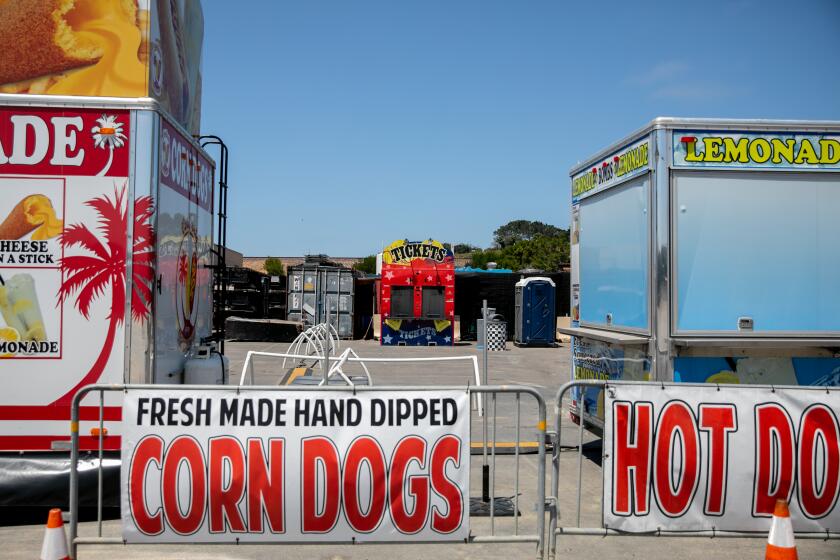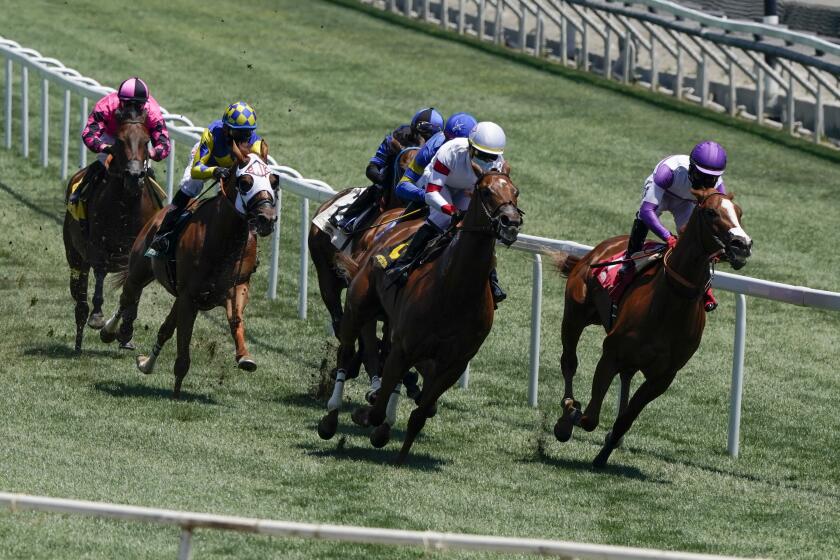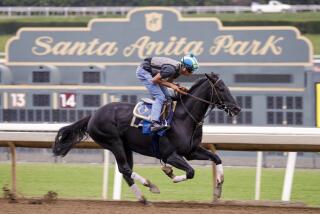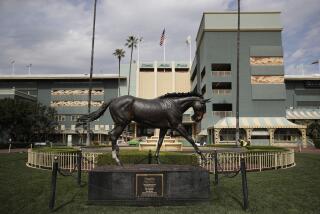New Santa Anita GM Nate Newby sees a bright future ahead despite challenges
Nate Newby, 43, is the fourth top management person at Santa Anita in the last four years. One was fired, one was moved and left the company, one was promoted and now Newby has been tasked with saving the iconic Southern California horse racing track. He comes to the role of general manager after a long time as the track’s chief marketing officer.
He spent the last year as assistant general manager to Aidan Butler, who was made the chief operating officer of the Stronach’s Group’s racing division. Newby joined Butler in quarantining in the jockey trailers during part of the pandemic. He recently spoke to the Los Angeles Times to explain his vision and challenges. His answers were edited for clarity and length.
Why are you the best person to do this job?
I’m passionate about Santa Anita and I’ve got experience having been here about 20 years. I know the issues and the things we just went through. I have experience on the front side of the business and the back side as far as understanding their perspective. I’m also very interested in [horse player] side of the business. I play in handicapping contests and most of my friends are horseplayers. I understand their perspective and from the marketing side of Santa Anita certainly know the challenges of making new horse racing fans and developing our business on that. It’s a good well-rounded perspective.
Did you learn anything those days and nights you spent in the jockey trailers?
It was probably one of the best experiences I’ve had in my career. Just getting to know the jockeys, to spend that much time with them and live with them, you get much closer than you would going to dinner and hanging out at the track. I got to know them well and build some trust and they got a good understanding of our perspective of running the track. … We developed a unique bond that only a circumstance like that could have brought.
Entertainment contracts are canceled for 2021, fair is scaled back and the horse park is closed.
What is the biggest problem you need to solve?
Improving our product. Southern California and Santa Anita have over the years been the gold standard of racing. We have the quality, we have the best horses in the world and that shows in the premier events — the Triple Crown races and Breeders’ Cup. Putting on a better day-to-day product for our horse players is key. My top priorities, 1 and 1a, are continuing our safety initiatives, making sure we’re safe for both horses and riders.
What’s the best idea you want to implement?
One thing I’ve learned over the last 19 years is everyone is always looking for the magic bullet or the quick fix that will change everything. We’ll continue to look for that but I’m not optimistic there is one thing. Racing and Santa Anita and our business have made a lot of little decisions that puts us on the right track over the long run. The new turf chute really focuses the racing on the turf at Santa Anita, which given the weather and the winter schedule here will differentiate us from our competitors. Having the ability to run 6 ½ [furlongs], 6, 5 ½, 5 has gotten us interest from barns on the East Coast and that’s going to really help. The Sunshine bonus is a more consistent horse recruitment program. Del Mar has a similar program and that’s going to get people to come to California and help our product. We were able to increase overnight purses and that obviously helps as well.
Is there any chance sprint racing will return to the downhill turf course?
We never rule anything out, we’re just trying to bring the best racing we can to Santa Anita. We are using the downhill course for our marathon races and everything put together they make for a really good turf program.
What metric will you use to measure success?
Our safety statistics will be a priority. Handle and field size, both related to our product, are key to show we are going in the right direction. I can be pretty happy with those metrics.
Do you have a budget or can you do what you need to fix problems?
We’re really lucky with our team of [CEO] Craig [Fravel] and Aidan [Butler] and our ownership of Belinda [Stronach] are very supportive. Over the years anything we need and asked for we’ve been able to get. We’ve spent a lot of money both improving the facility and a better customer experience over the last five or six years. And there is the new turf chute this year.
Do you see a chance to go back to a four-day week during this meeting?
I’m not so sure about this meeting, but it is absolutely our goal to get back to four days because that makes for a healthier circuit, but we need to continue to build the horse population, get more barns to come out here. I don’t know about six months, but absolutely it’s our goal in the next year or two.
The Horseracing Safety and Integrity Act was passed by Congress as part of a push to standardize medical and safety procedures within the sport.
Why did you need to make changes in the racing department?
Chris Merz has good experience with California coming up through the ranks. He knows our horse population well and gained more experience in Maryland. He brings a great youthful energy.
What has Santa Anita done for all the employees that have been out of work for nine months?
Like every business, we are keeping as much of our team together as we can. We’ve used reduced hours and furloughs. The various unions, especially those that are tied to on-site, crowds, food and beverage, are all in the same boat waiting for sports to open back up. Different groups have had healthcare extended but it’s difficult to give one general answer.
Can horse racing survive?
I think the current business model needs to adapt. I think there is no question about that. In general, the industry over the last 30 years has been slow to adapt and a lot of those issues are coming to the forefront now. We need to make the right business decisions for horse racing to thrive for the next 50 years.
More to Read
Go beyond the scoreboard
Get the latest on L.A.'s teams in the daily Sports Report newsletter.
You may occasionally receive promotional content from the Los Angeles Times.













